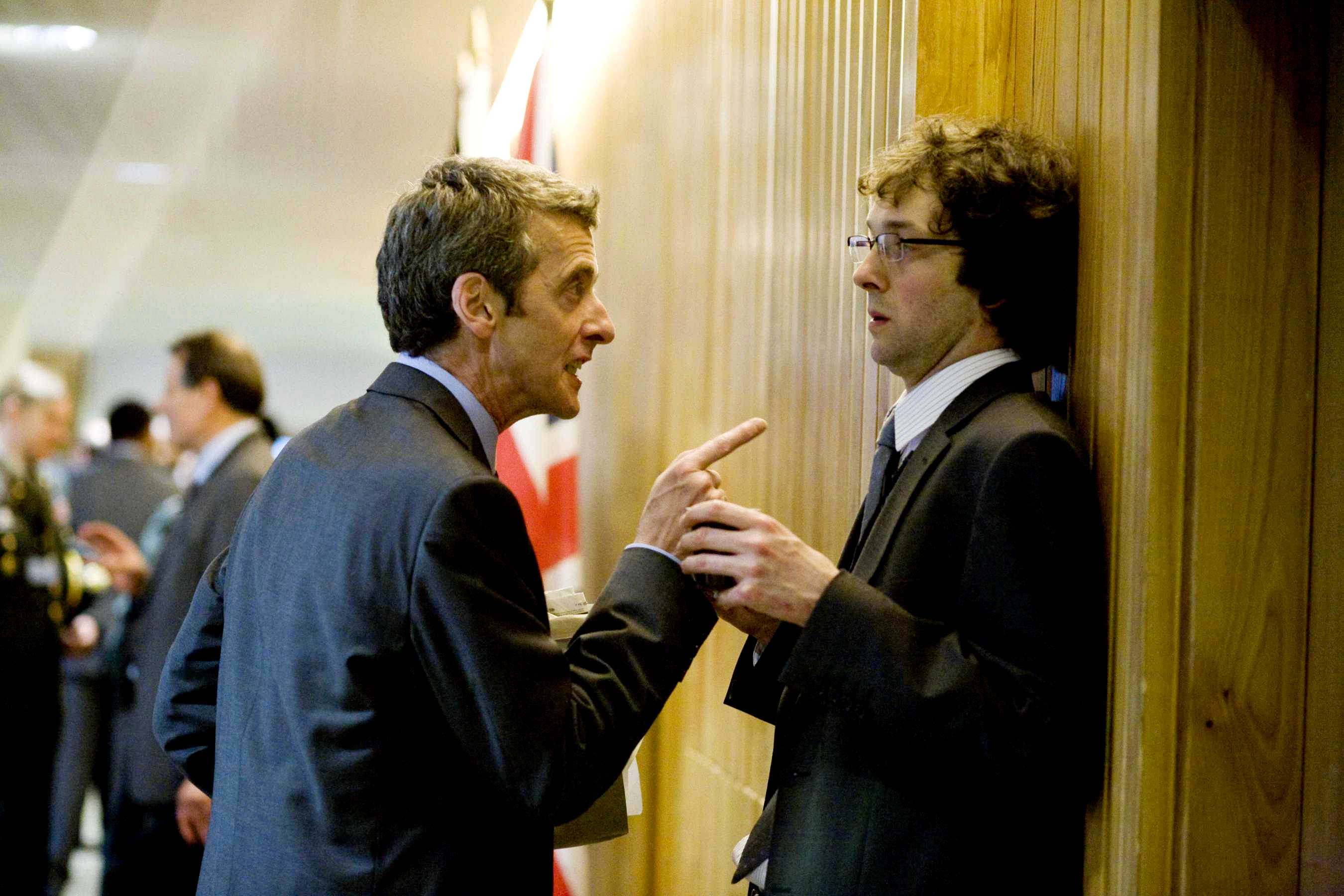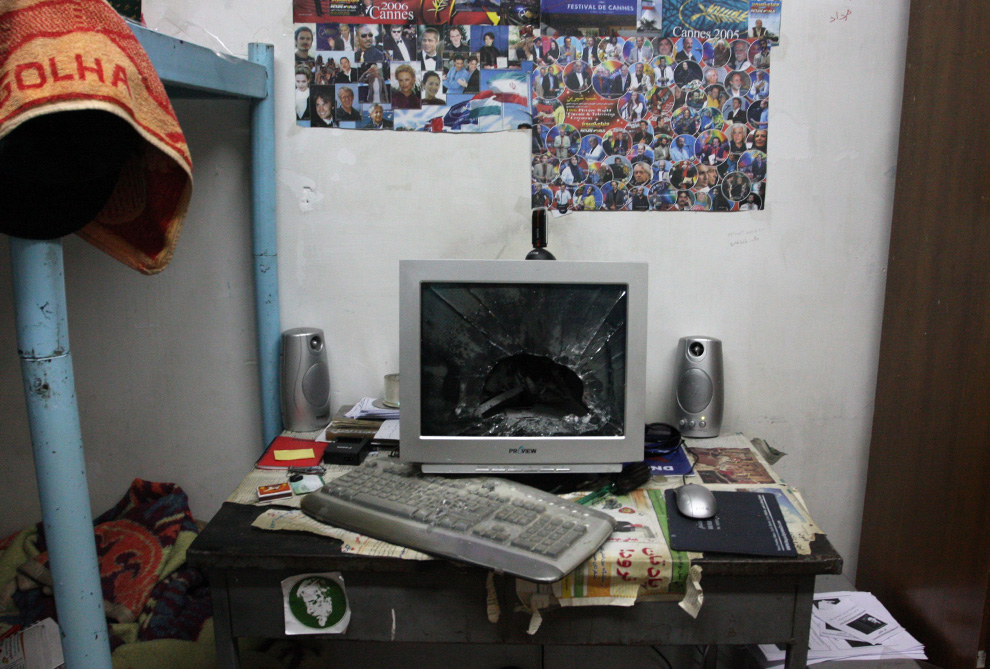Somebody was going to get to the bottom of this whole WMD thing eventually — it might as well be Jason Bour…Oh, wait, he’s not Bourne this time? Well, close enough for government work. Matt Damon and Paul Greengrass reunite in the new trailer for Green Zone, verrrrry loosely based on Rajiv Chandasekaran’s Imperial Life in the Emerald City and co-starring Amy Ryan, Brendan Gleeson, and Greg Kinnear. Great cast, and Greengrass hasn’t missed yet — I’m in.
Category: The Middle East
State of Play.

But, that one small caveat aside — and to be fair, In the Loop is apparently based on a British TV show (The Thick of It) that was more timely (and is going in the Netflix queue) — this is a gut-bustingly funny film. I honestly can’t remember the last time I laughed so hard in a theater. (Alas, it was probably 21 Grams, and that was for all the wrong reasons.) True, given that this is a sharp-edged, basically anti-Dubya political satire that goes out of its way to reward pop-culture geekery (Frodo, Ron Weasley, and the White Stripes are all used as epithets at one point or another), I’m probably as close to a target audience for this sort of movie that’s out there. Nevertheless, if your sense of humor runs anywhere from squirmathons like The Office UK or Curb Your Enthusiasm to sardonic political comedies like The Candidate or Bob Roberts to the current-events commentaries of Stewart and Colbert, this movie is a must-see. (And if you don’t find hyperarticulate Scotsman Peter Capaldi spewing forth rococo profanities funny just yet, you probably will after watching In the Loop.)
Iannucci’s film begins with another day in the life of Malcolm Tucker (Capaldi), the tough-as-nails, take-no-guff director of communications at 10 Downing St. (Think Rahm Emanuel, but funny.) This particular morning, Tucker quickly becomes enraged by the latest slip-up by the seemingly ineffectual Minister for International Development, Simon Foster (Tom Hollander, best recognized in America from the Pirates sequels.) To wit, Foster responded to a direct press question about an impending Mideast conflict by blurting out that “war is unforeseeable.” This is not “following the line,” as Tucker puts it, but after a stern rebuke, the Minister — and his communications team, new guy Toby (Chris Addison) and competent veteran Judy (Gina McKee) — only compound the error. Foster gets completely lost in the thicket at a follow-up press avail, and soon manages to mangle his way through to an even more unwieldy soundbite: “To walk the road of peace, sometimes we need to be ready to climb the mountain of conflict.” (Tucker’s livid response to this policy breach: “You sound like a f**in’ Nazi Julie Andrews.“)
Nonetheless, this sort of Zen pronunciamento is exactly the sort of thing the big boys in Washington want more of, even if no one (least of all Foster) seems to know what exactly he was driving at. Soon both the Hawks (represented by a Rumsfeldian David Rasche) and the Doves (mainly State Dept. deputy Mimi Kennedy and peacenik general James Gandolfini) think they’ve found an ace-in-the-hole in the confused minister. Meanwhile, this being Washington, a town that’s “like Bugsy Malone, but with real guns,” there’s another tier of shenanigans brewing under the principals. State Dept. aide Liza Weld (Anna Chlumsky) has penned a career-killing memorandum — soon acronymed, in DC fashion as “PWIP PIP” — that outlines the few pros and many cons of the imminent war. And Foster’s new man Toby has managed to inadvertently leak the real name of the War Committee to his friend at CNN — naturally, it was the committee with the most boring-sounding title.
Throw in a few more byzantine political subplots — more aides, committees, leaks, and whatnot — and simmer, and you have what amounts to the smartest, funniest political satire I’ve seen in a good long while. This is also clearly a movie that will reward repeat viewing, and I could see In the Loop someday being quoted as often and as lovingly in certain circles as The Big Lebowski. It may not be everyone’s cup of bile, I suppose, but if you’re generally a reader of this site, I’m guessing you’ll probably enjoy it as much as I did. So, if this movie is still playing in your area, go check it out…or brave the unholy wrath and frightening verbiage of Mr. Tucker. War may be “unforeseeable” — your enjoyment of In the Loop is not.

Dusty and the Black Sites.
“Eventually, the agency’s network would encompass at least eight detention centers, including one in the Middle East, one each in Iraq and Afghanistan and a maximum-security long-term site at Guantanamo Bay, Cuba, that was dubbed Strawberry Fields, officials said. (It was named after a Beatles song after C.I.A. officials joked that the detainees would be held there, as the lyric put it, ‘forever.’)“
Charming. The NYT gets a window into the CIA’s top-secret “black sites” program courtesy of former #3 man Dusty Foggo, who — irony alert — is currently serving a three-year term in a Kentucky jail on fraud charges associated with Duke Cunningham. (I presume Kentucky’s finest have yet to break out the “enhanced interrogation techniques” on this joker. Speaking of which, “[n]othing exotic was required for the infamous waterboards — they were built on the spot from locally available materials…The cells were constructed with special features to prevent injury to the prisoners during interrogations: nonslip floors and flexible, plywood-covered walls to soften the impact of being slammed into the wall.“)
Frere Jacques, Dormez-Vous?
z'[W]ith Reagan, the prophecy appreciation part of his brain functioned quite independently of the part that started wars (there’s nothing in the Old Testament about Nicaragua or even Grenada). Bush seems to have taken the threat of Gog and Magog to Israel quite literally, and, if this story can be believed, to have launched a war to stop them.“
One rather frightening story from a few days ago: As if the recent “Onward Christian Soldiers” war reports in GQ weren’t Crusadery enough, it appears that Dubya explictly invoked the End of Days to convince Jacques Chirac to get involved in the Iraq War, making his appeal Christian-to-Christian about the unholy dangers of Gog & Magog. Uh, really? (Apparently, Chirac has confirmed it.)
Hurts so Good.

As The Hurt Locker opens, we meet a three-man Explosive Ordnance Disposal (EOD) team out of Bravo Company doing what they do best: locating, examining, and disposing of an Improvised Explosive Device (IED) in the streets of Baghdad. Even on a run-of-the-mill call like this, and despite the jaunty banter among team members — the temperature is rising, the tension is thick, and the situation is life-or-death. For the IED in question could blow at any moment and take out everybody around…or it could be triggered by any one of the onlookers gathered, perhaps innocuously, perhaps not, to watch the soldiers work. Well, in this particular case of somebody-setting-us-up-the-bomb, things happen to go terribly awry. And, only six weeks out from the end of Bravo Company’s deployment, a crucial spot opens up on this EOD team.
Enter Staff Sgt. William James (Jeremy Renner), an amiable, reckless, possibly suicidal fellow who, not unlike Harry Tuttle, “came into this game for the action, the excitement. Go anywhere, travel light, get in, get out, wherever there’s trouble, a man alone.” (It’s this same devil-may-care attitude and notable lack of self-protective instinct, presumably, that eventually got him reassigned to zombie-stricken London.) Particularly showing up as he does so close to Bravo Company’s ship-out date, James’ cowboy moxie in the field causes huge headaches for his teammates (Anthony Mackie, Brian Geraghty), who even at one point contemplate fragging the guy. But, just as Jimmy McNulty is startlingly good po-lice despite his many disastrous personal foibles, Staff Sgt. James turns out to be surprisingly in his element whenever the situation deteriorates. And, amid the alleyways, warehouses, dust, and rubble of the Emerald City, the situation tends to deteriorate pretty much constantly.
The Hurt Locker isn’t really a commentary on our Iraq excursion like other movies in the genre we’ve seen of late. (Grace is Gone, Lions for Lambs) Like Generation Kill, it aims mainly to recreate the visceral experience of the war by getting us into the headspace of the men on the front lines. Inasmuch as there is a wider moral to this tale, it’s found in the epigram — “war is a drug” — taken from Chris Hedges’ War is a Force that Gives Us Meaning. Or, if you’d prefer, the same point is found in the first ten minutes of Apocalypse Now: “When I was home after my first tour, it was worse…I hardly said a word to my wife, until I said ‘yes’ to a divorce. When I was here, I wanted to be there; when I was there, all I could think of was getting back into the jungle.“
Scratch a little deeper, tho’, and you can find glimmers of a wider critique of the Iraq fiasco in Bigelow’s film — indeed, you could argue that these moments have more force because they’re so throwaway. After a Iraqi cabbie breaks a cordon, stares down the EOD team for unclear reasons, and is summarily carried away after finally backing down, James quips, “Well, if he wasn’t an insurgent, he sure is one now.” Later, David Morse briefly appears as some high-ranking muckety-muck akin to Godfather who has little regard for Geneva niceties, and Ralph Fiennes and Jason Flemyng also show up as British operatives looking to make some easy quid as bounty hunters on the side.
These small moments notwithstanding, The Hurt Locker is mostly apolitical, focusing mainly on the men (and it’s just men here) who find themselves deep in the midst of the suck. And, on that level, it’s a rousing success. In all honesty, the film cheats a bit by giving this EOD team a wider set of experiences than I think is probably likely — at various points they are forced into sniper and resource extraction missions by the course of events. But, that’s a quibble — for the most part Hurt Locker is as tense a thriller as I’ve seen in years.
Bigelow understands intuitively what far too many action directors these days miss: It’s not the size of the explosion or the volume of bullets fired that determine the quality of an action flick, but the slow, remorseless buildup to the potentially deadly events. In vignette after vignette, The Hurt Locker ratchets up the suspense by degrees, until you find yourself — like the EOD team we’re following — living out each moment in a heightened state of tension, endlessly waiting for the other shoe to drop. It’s an impressive moviemaking feat, and it helps to make The Hurt Locker one of the best films of the year.

Tehran v. Twitter.

As protests — and violence — escalate in Tehran after last week’s dubious election returns, the world increasingly looks to social networking sites to ascertain what’s really going on in the streets. The revolution may not be televised, but — so far at least — it seems to be managing quite well with Twitter: “This is a country where you have tens of thousands of bloggers, and these bloggers have been in a situation where the Internet has been filtered since 2004. Anyone worth their salt knows how to find an open proxy [to get around government firewalls and filters], knows how to work around censorship…The Iranian government, by filtering the Internet for so long, has actually trained a cadre of people who really know who to get around censorship.“
Update: Over at Salon, Iranian-American journalist Hooman Majd (who’s making the rounds — I saw him on the Lehrer News Hour yesterday as well) argues that the role of social networking has been vastly overstated: “More people have access to the Internet in Iran than other Middle Eastern countries but often it’s dial-up, it’s slow, they don’t do it like we do all day long…The depiction of the Internet revolution isn’t quite accurate. We’re putting our own image onto Iran. Of course there are people Twittering from the demonstrations; they’re just not representative of the vast majority of Iranians. What was so heartwarming about this whole thing is that the Iranian people stood up in mass and said you can’t take this away from us.“
Rosen: Stop me before I blog again!
“How absurd is that? Let us count the ways. First, even when the most establishment ‘journalists’ such as Rosen get caught engaging in patently irresponsible behavior, they still find a way to blame blogs rather than themselves (I thought I was just blogging, and reckless gossip is what bloggers do.) It wasn’t blogs that “reported” Saddam Hussein’s acquisition of scary aluminum tubes for nuclear weapons or that Iraq was behind the anthrax attacks; it wasn’t blogs that glorified Jessica Lynch’s nonexistent heroic firefight with Iraqi goons; it wasn’t blogs that turned John Edwards into The Breck Girl and John Kerry into a “French-looking” weakling; and it wasn’t blogs that presented retired military generals who were participating in a Pentagon propaganda program and saddled with countless undisclosed conflicts as ‘independent analysts.’“
Call it the State of Play fallacy: After TNR’s Jeffrey Rosen blames “blogging” for the obviously poor quality of his recent Sotomayor hit piece — and vows never to blog again — Salon‘s inimitable Glenn Greenwald sets the record straight about what can and can’t be pinned on bloggers. “Despite his efforts to blame ‘blogging’ for what he did, Rosen didn’t use journalistically reckless methods to smear Sotomayor’s intellect because of some inherent attribute of the medium. Instead, he did that because…that’s how the establishment media typically functions: ‘background reporting from people with various axes to grind, i.e. standard Washington reporting.’” (And, for what it’s worth, Rosen’s original article was hardly what you’d call blogging anyway — it was just a lengthy piece that ran online.)
Onward, Christian Soldiers.

Also linked in Rich’s piece is a damning profile of Donald Rumsfeld’s tenure at Defense by GQ’s Robert Draper, which happens to include these bizarre and, diplomatically speaking, blatantly idiotic Christian-minded cover sheets created especially for Dubya’s briefings. “This mixing of Crusades-like messaging with war imagery, which until now has not been revealed, had become routine…At least one Muslim analyst in the building had been greatly offended; others privately worried that if these covers were leaked during a war conducted in an Islamic nation, the fallout–as one Pentagon staffer would later say — ‘would be as bad as Abu Ghraib.’ But the Pentagon’s top officials were apparently unconcerned about the effect such a disclosure might have on the conduct of the war or on Bush’s public standing…Rumsfeld likely saw the Scriptures as a way of making a personal connection with a president who frequently quoted the Bible.”
But Wait, It Gets Worse.

|
‘How many fingers, Winston?’
‘Four. I suppose there are four. I would see five if I could. I am trying to see five.’ ‘Which do you wish: to persuade me that you see five, or really to see them?’ ‘Really to see them.’ ‘Again,’ said O’Brien. Perhaps the needle was eighty — ninety. Winston could not intermittently remember why the pain was happening. Behind his screwed-up eyelids a forest of fingers seemed to be moving in a sort of dance, weaving in and out, disappearing behind one another and reappearing again. He was trying to count them, he could not remember why. He knew only that it was impossible to count them, and that this was somehow due to the mysterious identity between five and four. The pain died down again. When he opened his eyes it was to find that he was still seeing the same thing. Innumerable fingers, like moving trees, were still streaming past in either direction, crossing and recrossing. He shut his eyes again. ‘How many fingers am I holding up, Winston?’ ‘I don’t know. I don’t know. You will kill me if you do that again. Four, five, six — in all honesty I don’t know.’ ‘Better,’ said O’Brien. |
Hard to believe, but, this morning, the recent grisly revelations of Dubya-era torture practices became even more horrifying. As we’ve gleaned more info over the past few days, certain obvious and troubling questions kept popping up. Why, as indicated here, would higher-ups insist on additional waterboarding sessions for Zubadayah, even after the CIA agents at hand thought the suspect “had given up all the information he had“? Also: Mind you, even one session of torture is reprehensible — and illegal — enough. But what more did the powers-that-be think they were going to get out of these suspects after ten waterboardings? Twenty? One hundred?
Well, now we know. Not only did Dubya apparachiks conceive a torture regime well before it was approved (and before they had any prisoners on hand — see also the new and unredacted Armed Services Committee report), but they tortured their suspects into the ground because they were trying to prove a false positive, i.e. that there was some serious operational link between Iraq and Al Qaeda that could be used to sell the second Gulf War. (See also the forged Habbush letter.)
“‘There were two reasons why these interrogations were so persistent, and why extreme methods were used,’ the former senior intelligence official said on condition of anonymity because of the issue’s sensitivity. ‘The main one is that everyone was worried about some kind of follow-up attack (after 9/11). But for most of 2002 and into 2003, Cheney and Rumsfeld, especially, were also demanding proof of the links between al Qaida and Iraq that (former Iraqi exile leader Ahmed) Chalabi and others had told them were there.‘”
So, in short, it would seem the suspects held by the CIA were tortured over and over again because they would not concede that two plus two equals five.
Really, how much lower can these assholes sink? What could they possibly do that would cause more violence to our ideals, or that would make our cherished role as a beacon of freedom seem any more ridiculous in the eyes of the world, than what they’ve already done?
Once again, I’m reminded of Lincoln’s famous remark to the Indiana 14th: “‘Whenever I hear anyone arguing for slavery, I feel a strong impulse to see it tried on him personally.‘” At the very least, somebody, or somebodies, better go to jail for a loooong time for this. Anything less is simply unacceptable.
Harman on the Hook.
“‘It’s the deepest kind of corruption,’ said a recently retired longtime national security official who was closely involved in the AIPAC investigation, ‘which was years in the making. It’s a story about the corruption of government — not legal corruption necessarily, but ethical corruption.” In a fascinating (and depressing) must-read, Congressional Quarterly‘s Jeff Stein lays bare a byzantine corruption scandal involving AIPAC, the Dubya WH, and Jane Harman, former Democratic chair of the House Intelligence Committee and, some grumbling aside, basically a “team player” for Dubya during the illegal and warrantless wiretaps episode. (Irony of ironies, it appears Harman’s misdeeds were caught on — a court-approved — wiretap.)
Talking Points Memo offers a handy timeline of the case here. Basically, on one level it’s your basic political quid-pro-quo. Harman told an unnamed suspected Israeli agent that she would “waddle into” a federal espionage case then extant against two members of AIPAC and gum up the works somehow. In return, “the suspected Israeli agent pledged to help lobby Nancy Pelosi…to appoint Harman chair of the Intelligence Committee after the 2006 elections.” (It didn’t take: Pelosi instead chose Silvestre Reyes.) “Seemingly wary of what she had just agreed to, according to an official who read the NSA transcript, Harman hung up after saying, ‘This conversation doesn’t exist.’“
Sordid enough. But what’s a mid-oughts scandal without the Dubya angle? After she had been caught on said wiretap, a federal investigation into Harman was approved…for awhile. But it seems Attorney General Alberto Gonzales now knew he had Harman in his pocket, and took advantage accordingly. “According to two officials privy to the events, Gonzales said he ‘needed Jane’ to help support the administration’s warrantless wiretapping program, which was about to be exposed by the New York Times. Harman, he told [CIA Director Porter] Goss, had helped persuade the newspaper to hold the wiretap story before, on the eve of the 2004 elections. And although it was too late to stop the Times from publishing now, she could be counted on again to help defend the program. He was right. On Dec. 21, 2005, in the midst of a firestorm of criticism about the wiretaps, Harman issued a statement defending the operation and slamming the Times, saying, ‘I believe it essential to U.S. national security, and that its disclosure has damaged critical intelligence capabilities.’“
Not that I need to remind anyone here, but Dubya’s use of illegal and warrantless wiretaps would, in more cases, be recognized as an impeachable offense. As it was, the Senate GOP (then in the catbird seat) held firm against hearings, and many of our congressional Dems — Feingold, Leahy, and a few other lonely souls notwithstanding — folded like a house of cards. Now, at least in the case of Harman, we know why.
Update: The NYT weighs in with their side, and it’s TLDR’ed by TPM. And Salon‘s Glenn Greenwald has a good bit of snarky fun with Harman’s recent “road to Damascus” moment regarding wiretaps.
